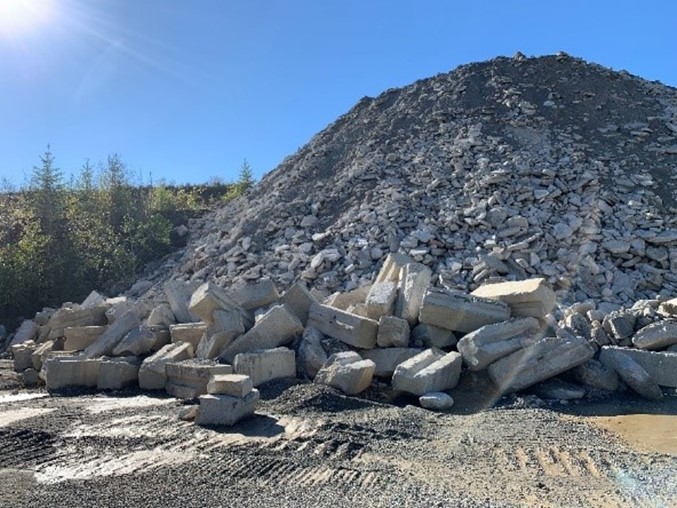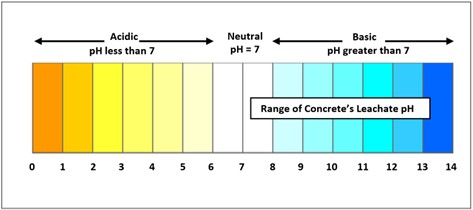
Concrete rubble piles like this one are stored at facilities across the state.
Concrete structures like buildings, foundations, and sidewalks, might seem like they will last forever, but modern-day concrete structures generally do not last longer than 50 to 100 years. Concrete is widely used in construction because it is resilient, affordable, and easily available. At the end of their use, concrete structures and products are demolished into rubble (broken up pieces). This rubble can get stored, recycled and reused as building material for structures, roads, sidewalks, and other uses.
Recycling demolished concrete is beneficial since it decreases greenhouse gas emissions, prevents the use of new, raw materials, and reduces production costs. At the same time, the sheer quantity of concrete rubble collected and stored statewide may create unintended water quality issues. In 2017 alone, Washington State collected nearly 1.2 million tons of concrete rubble, that weighs the same as three Empire state buildings. This demolished concrete rubble is typically stored outside at Sand and Gravel facilities, for recycling and reuse in construction projects.
Concrete recycling and manufacturing facilities have water quality permits from Ecology to ensure facilities follow best management practices to avoid polluting Washington’s waters. Today, we are taking a closer look at concrete, including a new study to learn more about the types of pollution that might be coming from concrete rubble.
What’s in concrete?
Concrete is more than a bunch of rocks. It is a mixture of many materials called aggregates, such as, sand, gravel, and/or crushed stone held together by a “glue” called cement. Cement is another mixture – made from processed limestone, clay, and water. Adjusting the amounts of all these materials give concrete its unique physical and chemical properties.

Once concrete has hardened into the durable material we commonly see, such as sidewalks or building foundations, it becomes an impervious surface, meaning rainwater runs off of it. However, when concrete is broken up into rubble and stored in piles waiting to be recycled, rainwater can flow through the piles. This new study will look at if rainwater is picking up contaminants, and if so, to what degree. This runoff is called stormwater. We manage stormwater and protect water quality through a number of permit programs.
Understanding concrete rubble and water quality permits
We review and update water quality permits every five years. In reality, this work never stops as we are always reviewing relevant information and learning from permit implementation. However, permits expire every five years, so we take the permit cycle time to update permits as needed. The next time we will update the Sand and Gravel permit is 2025.
One important part of updating a permit is to review the latest research to ensure current permit requirements are protective of water quality. Recently, we reviewed over 200 articles, reports, and papers published in the U.S. and internationally to help us understand what happens when rainwater interacts with concrete rubble and what potential pollutants might leach out into the water that could affect water quality.
The literature review found a list of potential pollutants associated with storing concrete rubble. However, none of the studies we reviewed had information on environmental impacts specific to concrete mixtures made in Washington. For more details, read our report: Recycled Concrete Aggregate Leachate: A Literature Review.
As a follow up to the literature review, we’ve started a new study to learn more about concrete rubble in Washington. We are measuring pH, metals, and other properties of the water that interacts with concrete rubble. The study will investigate if water quality is affected when rainwater mixes with concrete rubble stored for future recycling.
You’re basic! Even for concrete it’s a bad thing
pH is the measurement that tells us whether something is acidic or basic, also called alkaline. Too acidic or too basic can be bad for the environment. The tap water we drink is generally around a 7 on the pH scale, also called a neutral pH.
Rainwater that mingles with concrete rubble and flows from storage piles is commonly called leachate and often discharges to water bodies or groundwater. One potential concern from concrete rubble is the pH of this leachate. When concrete is demolished, the freshly crushed material has a high pH value and is basic. If rain falls on improperly managed and newly crushed concrete rubble, the leachate can make receiving waters more basic and more turbid (cloudy), which may harm aquatic life. As concrete sits over time, it absorbs carbon dioxide and becomes more neutral.
Tapwater generally has a pH of 7 which is neutral, at the center of the scale, water that is at either end of the scale isn't healthy for most aquatic life.
Other potential chemicals
Our literature review found that concrete rubble has the potential to release some chemicals at levels that are above the state’s water quality standards. However, the release of contaminants is dependent on several factors (such as pH, particle size, and age of the concrete). We found that the potential contaminants that could leach from concrete rubble are antimony, arsenic, barium, chromium, copper, lead, manganese, mercury, nickel, selenium, sulfur (as sulfate), and zinc. The study will evaluate if these contaminants are in concrete leachate and if they meet the state water quality standards. If any issues are discovered, we will determine the next steps to better protect waterbodies and groundwater.
Since the literature review didn’t have any Washington specific information, we don’t know how the data we reviewed compares to Washington concrete mixtures and if they are leaching out. With this in mind, we want to learn more about Washington’s permitted Sand and Gravel facilities to ensure the current management practices are preventing pollutants from concrete rubble from ending up in the water.
Studying Washington facilities
Washington concrete manufacturing and recycling facilities are already helping prevent concrete rubble runoff from affecting water quality. Our Sand and Gravel Permit requires facilities to develop site management plans, avoid placing stockpiles near surface water, not discharge water above a pH of 8.5 or below a pH of 6.5, and ensure there are no harmful substances in recycled concrete (like lead, asbestos, or PCBs). If concrete rubble is stored near drinking water wells, irrigation wells, or shallow groundwater, facilities follow additional groundwater monitoring requirements.
Our new study will allow us to characterize the amount and type of pollutants in discharges to waterbodies and groundwater and determine if permit updates are needed to better protect water quality. We plan to sample 80 facilities for antimony, arsenic, barium, chromium, copper, lead, manganese, mercury, nickel, selenium, sulfur (as sulfate), zinc, and pH and other field parameters. Our team at the Manchester Environmental Laboratory will analyze the samples. We have also worked with the Washington Aggregates & Concrete Association in developing this study.
For more study details, read the Quality Assurance Project Plan which describes the schedule, design, and the field and laboratory procedures.
We are excited to have our teams out in the field, working with facilities, and look forward to sharing the results before proposing any changes to the Sand and Gravel General Permit.

